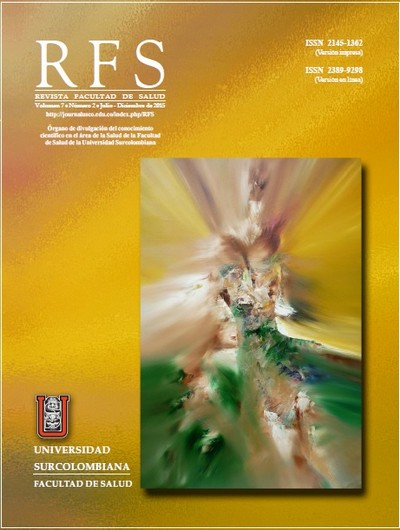Epidemiological characterisation of hospital-acquired infections in a private hospital in Neiva in 2013
##plugins.themes.bootstrap3.article.main##
Introduction. Hospital-acquired infections (HAI) have become a public health issue. In developed countries between 5 and 10% of patients contract one or more of these infections and it is believed that between 15 and 40% of patients in critical care units are affected. Method. A cross sectional study with an analytical approach was carried out in order to characterise the epidemiological features of HAIs in a private hospital in Neiva in 2013. The study included 251 confirmed cases. Results. The study determined that infections were most commonly a result of surgical procedures (SSI), particularly superficial surgical procedures (31.9%). The second major cause o f infections were infections associated with medical devices, predominantly urinary tract infections associated with catheters. Pneumonia associated with health care attention represented 14.3%. The fatality rate of HAIs was 9.5%; pneumonia and bloodstream infections accounted fo r the highest proportion of fatalities. Had a rate of 1.9%. Conclusion. The sociodemographic characteristics of cases of HAIs are similar to the performance of health institutions at a national level and that of developing countries.
Downloads
##plugins.themes.bootstrap3.article.details##
Lazzari S, Allegranzi B, Concia E. Making hospitals safer: the need for a global strategy for infection control in healthcare settings. World Hospitals and Health Services, 2004, 32, 34, 36-42.
Pittet, Didier. “Infection control and quality health care in the new millenium.” American journal of infection control 33.5 (2005): 258-267.
Rosenthal, Victor D. “Health-care-associated infections in developing countries.” The Lancet 377.9761 (2011): 186-188.
González, Laura, et al. “Infecciones intrahospitalarias en servicios de medicina interna y cirugía del Hospital Universitario de Neiva, 2012.” Revista Facultad de Salud- RFS 5.2 (2015): 27-33.
Department of health and human services. Action Plan to Prevent Health care – associated infections. 2009. [Internet]. Disponible en: http://www.hhs.gov/ash/initiatives/hai/actionplan/hhs_hai_action_plan_final_06222009.pdf
Secretaría Distrital de Salud de Bogotá. Boletín Epidemiológico de Infecciones Asociadas a la Atención en Salud. 2010. [Internet]. Disponible en: http://www.saludcapital.gov.co/sitios/VigilanciaSaludPublica/Todo%20IIH/Boletin_IIH.pdf
Dudeck, Margaret A., et al. “National Healthcare Safety Network (NHSN) report, data summary for 2012, Deviceassociated module.” American journal of infection control 41.12 (2013): 1148.
Peleg, Anton Y., and David C. Hooper. “Hospitalacquired infections due to gram-negative bacteria.” New England Journal of Medicine 362.19 (2010): 1804-1813.
Rosenthal, Victor Daniel, et al. “The attributable cost, length of hospital stay, and mortality of central lineassociated bloodstream infection in intensive care departments in Argentina: a prospective, matched analysis.” American journal of infection control 31.8 (2003): 475-480.
Rosenthal, Victor D., et al. “Time-dependent analysis of length of stay and mortality due to urinary tract infections in ten developing countries: INICC findings.” Journal of Infection 62.2 (2011): 136-141.
Rosenthal, Victor D., et al. “Time-dependent analysis of length of stay and mortality due to urinary tract infections in ten developing countries: INICC findings.” Journal of Infection 62.2 (2011): 136-141.










